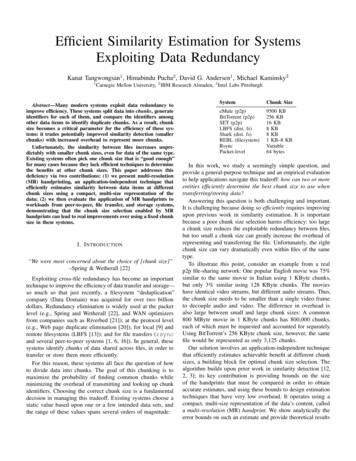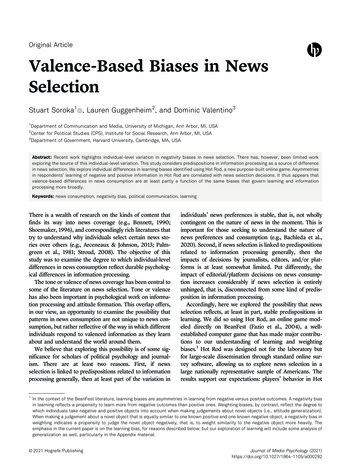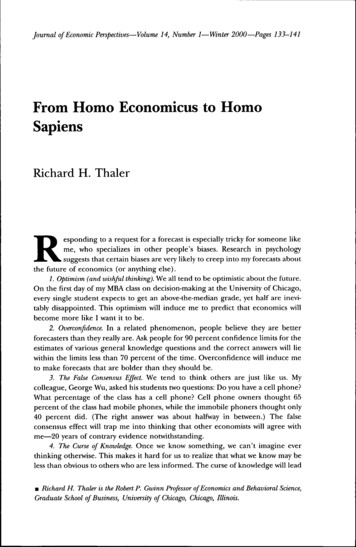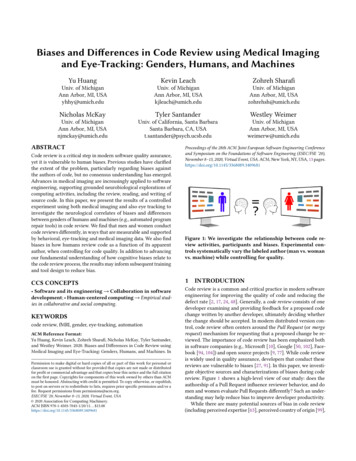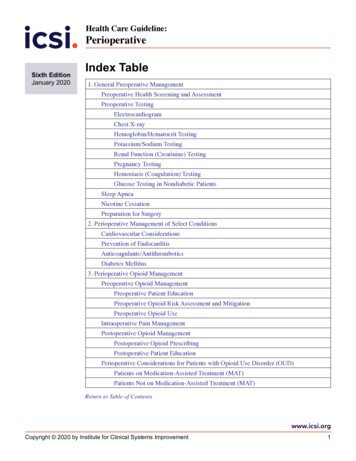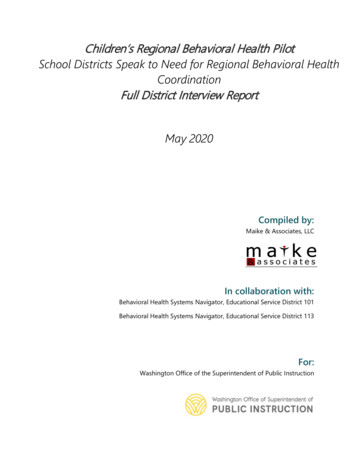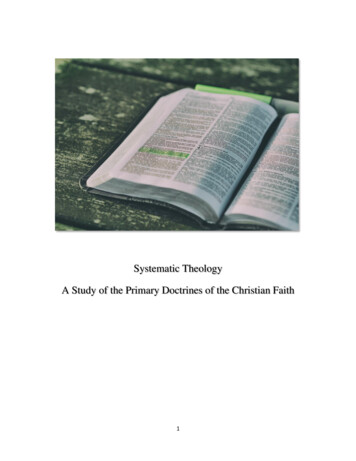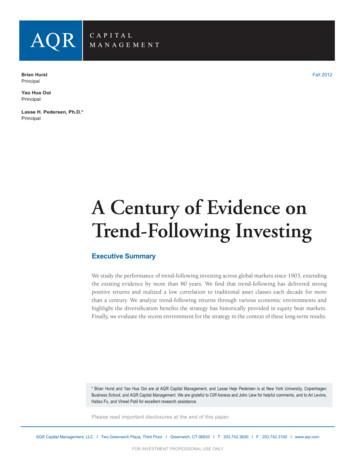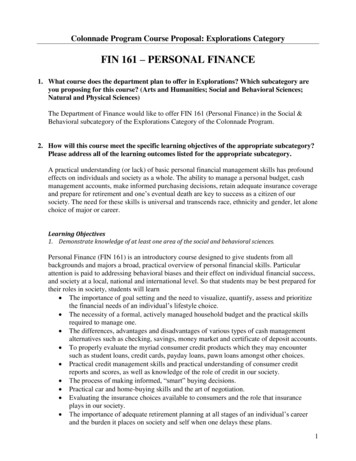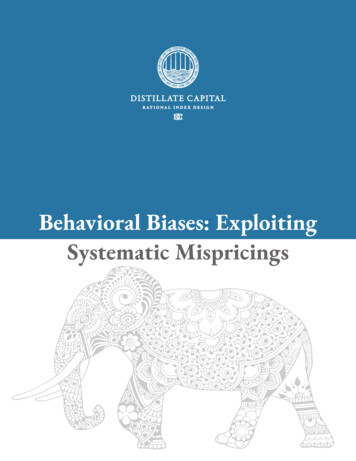
Transcription
Behavioral Biases: ExploitingSystematic Mispricings
Summary While economics ultimately determine asset prices, human behavior is a key element in understandingmarkets and how to make better decisions. Humans make decisions in a “dual process” system that is divided between a more dominant, older,instinctual, and faster system and a younger, slower, more methodical system. Conflicts between these systems and the dominance of the emotional system over the rational system result inbehavioral biases that are increasingly well documented in the expanding field of behavioral economics and instudies of brain activity. These biases create market mispricings that we seek to exploit in several ways:o We use a systematic process to minimize our own biases—like confirmation bias and herding.o Our process is designed to avoid “lottery stocks” which tend to be systematically overpriced.o We focus on companies with long-term fundamental stability where we think the odds ofoutperformance are more favorable.Our process seeks to exploit behavioral biases by foregoing some large outperformers, avoiding even more largeunderperformers, and capturing a disproportionate share of stocks that modestly beat the market.2
higher-level thinking is generally in control, it is no match forinstinct and emotion when they kick in.Behavioral Economics and MarketInefficienciesIt is the point that the elephant wins out over the rider in adisagreement that is so crucial to understanding behavioralbiases and why they are likely to persist. The explanation forthis dynamic between the elephant and the rider has its originsin how we and our brains evolved as a species.The field of behavioral economics has identified a myriadnumber of behavioral biases that affect human decision making.There is an increasingly rich body of work in the field that inessence shows how humans do not act like robots, as manyeconomic models and investment theories assume. Behavioraleconomics is also gaining wider acceptance and acclaim withDaniel Kahneman, Robert Shiller, and Richard Thaler allrecently receiving Nobel Prizes.The Evolution of the BrainHumans split from apes around 10 million years ago andgradually evolved into homo sapiens around 200,000 years ago.It was only 5,000 years ago that around half the humanpopulation engaged in farming rather than hunting andgathering and when the first writings appeared.4 Thus, for theoverwhelming majority of our existence as a species, it was oursystem-one decision making (the elephant) that largely kept usalive. It was only in the very recent past that higher-levelthinking (the rider) became so important. Psychologists LedaCosmides and John Tooby provide a nice summary of theimplications of this history:For investors, behavioral biases can undermine our decisionmaking if we fall victim to them. At the same time, however,they can create opportunities in financial markets for investorswho are able to exploit them. To understand these biases, andmore importantly, how to take advantage of the mispricingsthey create, it is first necessary to understand their origins andwhy they are likely to persist.The Elephant and the Rider“The key to understanding how the modern mind works is torealize that its circuits were not designed to solve the day-today problems of a modern America Generation aftergeneration, for 10 million years, natural selection slowlysculpted the human brain, favoring circuitry that was good atsolving the day-to-day problems of our hunter-gathererancestors Natural selection is a slow process, and there justhaven’t been enough generations for it to design circuits thatare well-adapted to our post-industrial life.”5Behavioral economists and psychologists generally agree on a“dual-process” view of human behavior. This consists of twoseparate systems for decision making. The first is fast-acting,more emotionally-driven, and can operate without consciousthought. The second system is slow, rational, and conscious.1Sometimes these two decision-making systems are framed asinstinct versus intellect, emotion versus reason, reflexive versusreflective, or gut versus brain. Daniel Kahneman evencontrasted them in the title of his famous 2012 book “ThinkingFast and Slow.” The Greeks, who arrived at this viewpoint longbefore scientists did, referred to them as Dionysus (emotion)and Apollo (reason).2Cosmides and Tooby summarize the result by stating that “ourmodern skulls house a Stone Age mind.”The evolution is mirrored in the physiological development of achild’s brain, which again highlights how our quick-thinkingsystem can overpower our rational thinking processes.According to world renowned child psychiatrist Bruce Perry,This “dual-process” system of thinking was also elegantlycaptured in Jonathan Haidt’s famous example of the elephantand the rider. As Haidt described in The HappinessHypothesis, the elephant is the automatic system that uses gutreaction and instinct, while the rider atop the elephant is thecontrolled system that is slower and driven by reason. The mostimportant element of Haidt’s example, though, is that the ridercan control and steer the elephant only when the elephantdoesn’t have desires of his own. 3 In other words, while our“[brain development] proceeds from central brain areaslocated toward the bottom of the brain upward and outward,roughly following the order in which the various regionsevolved. This means that the lower, more central areas are themost primitive, while the higher, outer regions mediate ourmost advanced functions like language. As the higher regionsdevelop, they gain some control over the lower areas.1 David Eagleman “Incognito: The Secret Lives of the Brain” 2011.2 Gardner “The Science of Fear” 20093 Jonathan Haidt “The Happiness Hypothesis” 2006.4 Leda Cosmides and John Tooby “Evolutionary Psychology: A Primer” 19975 Leda Cosmides and John Tooby “Evolutionary Psychology: A Primer” 19973
Nevertheless, even in adults, threat or distress shifts controlaway from the rational, abstract thinking areas to the moredecisive, rapidly acting central, lower regions. Underperceived threat we get dumber but faster, which can help ussurvive in a fire or when fleeing from a bad guy, but can alsoget us in trouble at work or in other social situations.”6Conflicts Between Our “Fast” and“Slow” Thinking Systems ProduceBehavioral BiasesThus, as brains are still forming in children, the more primitiveor emotional parts like the amygdala dominate much like theydid with our early ancestors. Anyone who has tried to reasonwith an angry two-year-old is well aware of this.Because the two systems of human decision making are notalways in sync and the emotional system is more powerful thanthe rational system, there are a litany of ways we make decisionsthat are irrational in our modern world. Many of these arereferred to as behavioral biases and are well documented inpsychology and behavioral economics. In Table 1, we havehighlighted a few of the most well-documented biases.But, as Perry notes, this same dynamic can take hold even in anadult brain when there is a perceived threat or other trigger forthe elephant to react quickly.While not as neatly organized and researched as the biasesdescribed by behavioral economists, investors often refer to thedangerous sway of greed and fear. We think there is a strongoverlap between these two investor-labeled emotions and manyof the biases that are outlined in academic literature. We usedgreed and fear as categorical groupings to discuss the biases thatwe think are relevant to our process.Human evolution and brain development are thus at the originsof the emotional biases in our decision making today. Sincethese biases are so deeply rooted in human evolution, it alsomeans that they are unlikely to change anytime soon. In otherwords, the elephant will continue to overpower the rider for along time to come.Behavioral economic researchers have identified a litany of biases that influence our decision making.Table 1: Common Behavioral BiasesAction Bias:The impulse to act in order to gain a sense of control over a situation to eliminate a problem. Investors can feel compelled to react to a stock pricechange or large market move. This may make an investor feel better about what has occurred, but can lead to a suboptimal decision.Anchoring:A priming effect in which people cling to an initial figure (even if it has no relation to the task at hand) and are swayed in their judgments aboutvalue. Anchoring to figures like an initial purchase price can heavily influence an investor’s decision to sell a stock.Availability orRecency Bias:An influence on people's judgments about the likelihood of an event based on how easily and vividly examples come to mind. Investors may recallextreme stock events or returns more readily and can be overly influenced by these outliers.ConfirmationBias:People tend to seek out or analyze information in a way that fits with their existing thinking. Investors often decide whether they like a stock andthen search for evidence to support their feeling.CumulativeProspect Theory:A model of how humans actually behave that shows how we tend to overweight the likelihood of small probabilities (like winning the lottery) andunderweight more likely outcomes, provide different responses based on how something is framed, and are risk seeking in certain situations, butgenerally loss averse and feel the pain of losses more than we derive pleasure from equivalent gains.EndowmentEffect:The tendency to overvalue something that we own. After an investor purchases a stock, he or she may become attached to it, think it is worthmore than it is, and be reluctant to sell it even if the original reasons for ownership no longer apply.Hindsight Bias:The tendency to look at past events with the benefit of hindsight and think they were more predictable than they were. An investor may look at anunderperforming stock and think with the benefit of hindsight that they could have avoided it and will be able to in the future.Overconfidence:The tendency to think we are more capable than we are. Investors buy risky stocks or take on long-term performance risk by holding highlyconcentrated portfolios, sometimes because they are overconfident.Self-AttributionBias:The tendency to attribute success or failure to personal skill rather than randomness or factors beyond one's control. This may make an investoroverconfident about their abilities.6 Bruce Perry “Born for Love” 20104
FearAnother study showed that financial losing streaks increaseactivity in the hippocampus of the brain.10 This part of the brainis next to the amygdala at the base, similarly develops early inchildhood and is part of the fast-thinking system. Since thehippocampus is involved in the creation of memories of fear andanxiety, it is theorized that its activation in market losing streaksnot only contributes to the panic involved in market crashes,but also explains why investors are slow to return to stocks afterpulling money out during large declines.11 Currently, the lowstock weighting of millennials despite their long time horizonsis thought to result from this phenomenon, and the fact theirinvesting experiences have been dominated by financial crises.12While the instinct of fear helped keep us alive for the majority ofhuman existence, it can undermine our decision-making asinvestors. Fear makes us prone to panic and selling out of a stockor the market overall at the worst possible time. This is born outin numerous studies, as well as in the tight relationship betweennet inflows into equity funds and the performance of the stockmarket (See Figure 2). Because investors pro-cyclically pullmoney out of the market when it is falling and they are fearful,but allocate more money when it is rising and they feel better,investor performance substantially lags the overall marketperformance on a dollar-weighted basis.7Fear is also thought to play a factor in investors’ systematicoverweighting of their home countries in their investmentportfolios, called home bias. A study by Peter Kenning at theUniversity of Munster in Germany showed that activity in theamygdala was triggered and associated emotions of fear arosewhen people considered investing in foreign markets.13Scientists have looked more closely at the impact of fear on ourdecision-making by tracking brain activity under differentscenarios with functional magnetic resonance imaging. Onestudy from 2001 found that winning or losing money leads to aspike in activity in the amygdala portion of our brains.8 This issignificant since the amygdala is part of the limbic system at thebase of the brain that is responsible for functions of selfpreservation and species preservation.9 The amygdala is also oneof the first parts of the brain to develop and is associated withthe reflexive and fast-thinking “elephant” system that tends todominate when the two decision systems are in disagreement. Inother words, when we lose money, our decision-making canshift out of the more developed, higher-thinking portion of thebrain and into the more emotional, lower portion of the brain.While this proclivity for making fear-based decisions may havekept us alive in prehistoric times, it can work strongly against usas investors in modern times.The anterior cingulate cortex (ACC) is another part of the brainthat can lead to suboptimal, fear-based decisions. This part ofthe brain is constantly taking in information and looking forpatterns even though there may be no conscious awareness thatthis is occurring. When a pattern is broken or something is outof place, the release of a hormone called cortisol triggers a feelingof fear or anxiety even before we become consciously aware ofwhat is going on. In early humans, this is thought to have beenan evolutionary advantage as it provided an early warningsystem for a dangerous situation. For investors, this fear triggerthat stems from a broken pattern is thought to explain the highvalue placed on predictability and the large negative pricereactions of companies that break a pattern.14 A study by IreneKim at the University of Michigan supports this theory as shefound that the longer a pattern lasts, the more a stock may selloff after it is broken. Specifically, she found that stocks thatreported earnings below expectations after previously beatingearnings three times, fell 3% while a stock that had exceededexpectations in the prior eight quarters fell by 8%.15Investor flows tend to be pro-cyclical and follow the market.Figure 2: Flows Into Equity Funds vs. the S&P 500 Index7 See Dalbar’s “Annual Quantitative Investment Decisions” studies andMorningstar’s annual “Mind the Gap” studies.8 Zalla, et al. “Differential Amygdala Responses to Winning and Losing: a FunctionalMagnetic Resonance Imaging Study in Humans” 20019 Swensen, “Review of Clinical and Functional Neuroscience” 200610 Elliott et al. “Dissociable Neural Responses in Human Reward Systems” 200011 Zweig, “Is Your Brain Wired for Wealth” Money Magazine October 200212 Liu, “Why Won’t Millennials Embrace the Stock Market” Barron’s July 31, 201713 Kenning, Mohr, Erk, & Walter “The role of fear in home-biased decision making:first insights from neuroeconomics” 200614 Zweig, “Is Your Brain Wired for Wealth” Money Magazine October 200215 Zweig, “Is Your Brain Wired for Wealth” Money Magazine October 20025
than the net returns to wagers with more favorable startingodds. 21 Nobel Prize winner Richard Thaler wrote about thisphenomenon the 1980s, but it has been subsequently studied inmultiple countries and in multiple different types of betting, allwith similar results.22, 23 One recent examination of 10 years ofdata in the U.K. and Ireland mirrored the original Thaler resultsand showed net returns to longshot wagers being substantiallymore negative than the net returns to wagers with morefavorable starting odds (See Figure 3).GreedOn the other side of fear is greed. And just like fear, it is deeplyrooted in our brains and benefited us from an evolutionaryperspective but can undermine the quality of our decisions asinvestors in modern times. Greed is hardwired into the way weexperience pleasure through the firing of dopamine neurons inour brains. Drugs like cocaine and amphetamines, for instance,work by activating dopamine neurons and limiting the reabsorption of dopamine to prolong their influence. 16 This isalso why drugs are sometimes referred to as “dope.” Somewhatalarmingly, the neurological response to monetary gains isremarkably similar to the dopamine release from these drugs.17Horse wagers show a systematic longshot bias in which gamblersoverpay for wagers with low starting odds.Figure 3: Returns on Horse Wagers by Starting OddsThe connection to greed comes from the fact that dopamineneurons begin to fire once a reward is expected and notnecessarily when it is received. When a reward is obtained andmatches expectations, the dopamine response subsides. It isonly if the obtained reward exceeds what was predicted that thedopamine response is increased. Since our expectations resethigher with each prediction that is exceeded, to continue gettingthe same positive prediction error and thus the same dopaminestimulation, the reward needs to get continuously bigger. 18Neuroscientist Wolfram Schultz described this as a “mechanismbuilt in by evolution that pushes us to always want more andnever want less.” 19 In early humans, it is thought that thepositive reward of a dopamine rush and desire for more mayhave been helpful in not only providing a mechanism of positivereinforcement in learning, but also in driving us to venturefurther afield to seek food. Evolutionarily, the thinking goes thiswould have provided an advantage to humans or apes whosebrains were not wired this way, and who may thus havestruggled to secure adequate sustenance.Studies have also found that when a reward is less likely, thedopamine response is larger and the neurons fire for longer. 24This means that we actually derive pleasure from taking risk insome situations. The ubiquity of gambling and lotteries insocieties across the world are powerful reminders that this is thecase as people knowingly accept negative expected net returnsout of the hope of a large win or the exhilaration of playing. Astudy by Strait and Hayden found that even monkeys exhibitthis behavior and produced a larger dopamine response to andpreference for risky rewards compared to safe rewards of asimilar size. 25 This can also push us to riskier longshotinvestments over less exciting, safer ones.In addition to hardwiring our brains for greed, there are severalother aspects of the dopamine response mechanism that haveimplications on how we make financial decisions. As rewardsget larger, the dopamine response gets disproportionatelybigger. This means that while we like winning, we really likewinning big, which makes us especially prone to desiringlongshot bets and overpaying for them.20There is also a neurological influence from the skewness of areturn distribution. The same study that looked at thedopamine responses of monkeys to different rewards identifieda dopamine-based preference for positive skewness, which is adistribution that has a small chance of a large reward but a lowermedian reward (See Figure 4). Imaging studies of human brainsStudies of horse race betting have consistently found a longshotbias in which gamblers systematically overpay for longshotwagers such that their actual payouts are significantly worse16 Schultz, Dayan, Montague “A Neural Substrate of Prediction and Reward” 199717 Breiter, Aharon, Kahneman, Dale, & Shizgal “Functional Imaging of NeuralResponses to Expectancy and Experience of Monetary Gains and Losses” 200118 Schultz “Dopamine Reward Prediction and Error Coding” 201619 Schultz “Dopamine Reward Prediction and Error Coding” 201620 Zweig, “Is Your Brain Wired for Wealth” Money Magazine October 200221 Thaler & Ziemba “Parimutuel Betting Marksts: Racetracks and Lotteries” 198822 Snowberg and Wolfers “Explaining the Favorite-Long Shot bias: Is It Risk-Love orMisperceptions” 201023 Berkowitz, Depken, and Gander “A Favorite-Longshot Bias in Fixed-Odds BettingMarkets: Evidence From College Basketball and College Football” 201624 Zweig, “Is Your Brain Wired for Wealth” Money Magazine October 200225 Strait and Hayden “Preference Patterns for Skewed Gambles in Rhesus Monkeys”20136
have found a similar hard-wired preference for positiveskewness. 26 This also indicates a neurological preference forlongshot investments.Industry Practices, the Media, andHerding Exacerbate BiasesHumans exhibit a neurological preference for positive skewness.Figure 4: Examples of SkewnessThere are also a variety of external factors that can exacerbate thebiases to which we are already predisposed.First, incentive structures at investment firms can lead investorsto favor lottery stocks. Compensation may be structured suchthat one or two large winners will reap substantially greaterrewards for an analyst than a number of more modestoutperformers. In addition, individual analysts generally haveonly a few stocks in an overall portfolio and so may want tomake those positions “count” by including stocks they thinkhave dramatically more upside. All of this would serve toexacerbate the lottery stock bias to which we are alreadypredisposed.Because of this hard-wired desire for large payoffs and skeweddistributions, we favor longshot investments and are prone tooverpaying for such stocks with lottery-like attributes just likewe do in wagering on horses. Academic studies of “lotterystocks” have generally found that because investors are prone tooverpaying for the potential for large rewards, these stocks as agroup tend to underperform. 27 One recent study used thepreference for “lottery stocks” to explain the low beta anomalyin which lower beta stocks outperform over the long-termdespite being less risky. Investors’ desire for positively skewed,lottery-like returns have also been used to explain the significantunderperformance of initial public offerings (IPOs) 28 anddistressed stocks.29Second, the use of volatility as a risk measure can exacerbate fearbased decision-making. If a stock falls sharply, its volatility willspike. If a portfolio manager uses a risk tool that is based onvolatility or is targeting an overall portfolio beta, he or she maybe forced to sell the stock if it trips a volatility trigger, or mayneed to sell the stock to keep the overall portfolio’s weightedaverage beta at a targeted level. The growing emphasis on suchmetrics may be intensifying the impact of fear-based biases.Third, to attract attention and get viewers or readers, the medialoves to stoke our fear and greed. Regarding greed, stocks orinvestments with stratospheric prior gains like bitcoin ortechnology stocks in the late 1990s create obvious excitementand capture attention. Such coverage can play on an investor’sgreed and lead him or her to jump into an investment at exactlythe wrong time. One of our favorite examples of the mediastoking greed and the desire for lottery-like big payouts was astory on Fox News that featured a “lottery expert” andencouraged people to buy as many lottery tickets as they couldafford to increase their chances of winning an 800 millionjackpot (See Figure 5).One final element of the way our reward mechanism works isthat it pushes us to favor immediate payouts. Studies haveconfirmed that the longer we wait for a reward after the initialsignal of expectation, the more the dopamine rush begins tofade. This is called temporal or hyperbolic discounting due tothe rate at which the dopamine response fades.30 This is closelyconnected to the behavioral bias called hyperbolic discountingin which people strongly favor immediate rewards. Forexample, someone might prefer 100 today over 120 in onemonth but when framed differently, would favor 120 in 13months over 100 in 12 months.31 This means that not only arewe hardwired to be greedy and favor longshots, but we want thepayoffs immediately. We think this contributes to the focus onshort-term price moves and overemphasis on quarterly earningsreports over long-term fundamentals.The media and financial commentators also love to play on ourfear. Analysts predicting the next market crash are frequentlyfeatured in the media as a financial version of the “if it bleeds, itleads” publishing motto. Firms or analysts offering investmentadvice also often compete for the attention of institutional andother investors through fear. Because of the hardwiring in ourbrains, this strategy works frustratingly often.26 Burke & Tobler “Reward Skewness Coding in the Insula Independent ofProbability and Loss” 201127 Barberis and Huang “Stocks as Lotteries: The Implications of ProbabilityWeighting for Security Prices” 200628 Ritter “The Long-Run Performance of Initial Public Offerings” 199129 Campbell, Hilscher, Szilagyi “In Search of Distress Risk” 200830 Koayashi and Schultz “Influence of Reward Delays on Responses of DopamineNeurons” 200831 Frederick, Loewenstein, and O’Donoghue, “Time Discounting and TimePreference: A Critical Review” 20027
The media often caters to our greed to attract attention and viewership.In one example of a strategist attracting attention through fear, a pricechart of the market crash in 1929 was overlaid on the 2014 price chart.Figure 5: An Example of Media Playing on Our GreedFigure 6: Dow Jones Index 2014 vs. 1929One tactic among such prognosticators is to overlay a chart ofthe current market price moves with a similar looking one thatinvolves a crash. Exactly such a chart was making the rounds inearly 2014. It showed a remarkable pattern between the marketthat year and the price moves of the market leading into the greatdepression and gave the impression that a market crash wasimminent (See Figure 6). Even knowing in hindsight that nosuch crash occurred, the chart still scares us. But when the axesof the chart are not manipulated, and both price lines areindexed to one, the apparent relationship disappears and so toodoes the imminent-seeming crash (See Figure 7).When both price charts are indexed and more properly compared, therelationship and seemingly imminent 2014 crash disappear.Figure 7: Dow Jones Index 2014 vs. 1929 Indexed to 1Lastly, herding can exacerbate and compound other behavioralbiases. Herding is an essential survival tool and has beenobserved across a variety of species in the animal kingdom. Butthe benefits of herding from an evolutionary perspective do nottranslate favorably into economics. Studies have found thathumans are more likely to make an investment if it is popular asthe section of the brain involved in reward-processing showsincreased activity when a stock is well-liked by other humans.32We are therefore prone to piling into an investment that is doingwell irrespective of its valuation. Conversely, facing a change inperception, we are also likely to rush as a group for the exit andmay severely depress the valuation of a stock or the overallmarket in the process. This effect can cause stocks or even entireasset classes to become significantly divorced from their longterm fundamentals.32 Burke & Baddeley “Striatal BOLD Response Reflects the Impact of HerdInformation on Financial Decisions” 20108
computed the historical co-variances of the asset classes anddrawn an efficient frontier. Instead, I visualized my grief if thestock market went way up and I wasn’t in it—or if it went waydown and I was completely in it. My intention was to minimizemy future regret. So I split my contributions 50/50 betweenbonds and equities.”33 Quite an admission indeed.Manifestations of BehavioralBiases in Financial MarketsGiven the litany of behavioral biases, their strong rooting in ourneurology, and the potential for external factors to exacerbatethem, it is no surprise that financial markets sometimes behaveerratically and irrationally. Most notably, financial bubbles haveexisted for as long as there have been markets in which to createthem. Table 2 highlights some of the more notable bubbles.Fischer Black, another legendary economist and proponent ofthe theory that markets are rational and efficiently priced,offered a definition of efficiency that seems to leave ample roomfor behavioral biases. He wrote, “we might define an efficientmarket as one in which price is within a factor of two of value,i.e., the price is more than half of value and less than twicevalue By this definition, I think almost all markets are efficientalmost all of the time. ‘Almost all’ means 90%.” 34 Instead ofeach stock price being perfectly accurate each day, Black’sdefinition of efficient means that 90% of the time the marketoverall could double in price or fall by half and still be properlypriced. This is a definition that does not appear inconsistentwith the idea that biases can lead to exploitable mispricings.It is also notable that even some of the most brilliant economists(including the very ones who advanced the idea that markets areperfectly rational) have fallen victim to behavioral biases. HarryMarkowitz received a Nobel Prize for creating modern portfoliotheory—a highly mathematical framework to analyze thetradeoff between risk and return in order to maximize expectedreturn at any given level of risk. But when asked about his owninvestment allocation, Markowitz replied, “I should haveAsset bubbles have been present for as long as markets have existed.Table 2: Famous BubblesTulips (1619 to 1622):In Holland, tulips became symbols of wealth and traded at extraordinary prices—as much as 20x the annual salary of a skilled craftsman.South Sea Bubble(1720):Shares in the British joint-stock company surged from 130 in February to 1000 in August of 1720 after the British government granted it amonopoly to trade in South America (even though Spain dominated the region).Railway Mania (1830s& 1840s):A period involving two bubbles
3 Jonathan Haidt "The Happiness Hypothesis" 2006. higher-level thinking is generally in control, it is no match for instinct and emotion when they kick in. It is the point that the elephant wins out over the rider in a disagreement that is so crucial to understanding behavioral biases and why they are likely to persist. The explanation for

